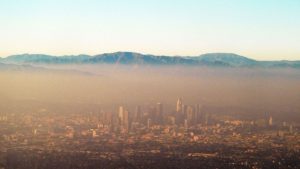Today is Halloween, and kids in the Los Angeles area will be out trick-or-treating, with many of them fearing that a zombie or a vampire will jump out at them from behind a tree. If only these creatures were the scariest things one should be afraid of. Unfortunately, there is a very scary monster in Los Angeles that is unnoticeable most of the time, but during the hot summer months, it comes out of hiding and makes itself visible. This monster is smog, and it creeps over the region.
Smog is the chemical reaction of nitrogen oxides (NOx) and volatile organic compounds with sunlight, resulting in ground-level ozone. Ozone causes adverse health effects. It enters the human body primarily through the respiratory tract and causes respiratory irritation and discomfort, and makes breathing more difficult during exercise. Sensitive populations, i.e. people with respiratory diseases, children and the elderly, and those who exercise heavily are more susceptible to the damaging effects of ozone.

The worst smog months in the greater Los Angeles region this year have been July and August, which is no coincidence since ozone levels are highest during the summer. During these months, the region was in extreme nonattainment of the 8-hour ozone federal air quality standard because it exceeded this standard on 28 days. This means that there were only three days each month when the federal standard was met and the air was relatively cleaner. June was also a bad month, with 24 out of 30 days exceeding the standard. There were so many days this past summer when you could see the smog haze covering the whole region. There were days when you could barely see the San Gabriel Mountains above Pasadena.
As of today, the South Coast has exceeded the federal 8-hour ozone standard on 107 days. That equals to 107 out of 305 days so far this year where the ozone levels have been extremely harmful to public health. So what efforts are taking place to remediate this situation?
The South Coast Air Quality Management District (Air District) – the pollution control agency for all of Orange County and urban portions of Los Angeles, Riverside and San Bernardino counties – is currently updating its Air Quality Management Plan (AQMP). This plan lays out how the agency intends to meet all the federal air quality standards, including the 8-hour ozone standard.
Unfortunately, the current draft of the plan update relies too heavily on voluntary and unfunded incentive programs. It should focus more on legally enforceable, quantifiable, verifiable and reasonably achievable emission reductions to realistically reach attainment. In order to do this, the AQMP must include additional commitment to regulations and emission control measures. The Air District should use its authority to adopt fleet rules requiring zero emission vehicles for government agencies and companies deploying large numbers of cars or trucks. It should also adopt an indirect source regulation requiring lower emissions for the operations of large warehouses. The trucks that travel to and from these facilities are major sources of NOx and fine particulate matter, causing major negative air quality and public health impacts.
The residents of the region have a fundamental right to breathe clean air. They should not fear what they are breathing. The AQMP needs to be a strong plan that sets the South Coast on an enforceable and mandatory path to clean air. Our children and grandchildren deserve no less. They should be scared of fictional monsters, not the real life monster that is smog.









Thanks for the post! I still can’t believe that such a big public health concern is not really being taken seriously… This will only get worse if regulations are not put into place.